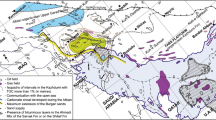Abstract
Based on simple but fundamental physical observations, a simple Kelvin model with degree of hydration based stiffnesses and viscosity is developed for the simulation of the visco-elastic behaviour of early age concrete, including instantaneous deformation and basic creep. The validity of the model is verified by means of creep tests under constant or varying stresses. A good agreement with the experimental creep results is noticed. With the newly developed degree of hydration based Kelvin model the fundamental nature of the degree of hydration for the early age creep behaviour is illustrated once again.
Résumé
Sur la base d'observations physiques simples mais fondemantales, l'auteur a établi un modèle Kelvin simple dont les paramètres sont basés sur le degré d'hydratation et qui permet la simulation du comportement visco-élastique du béton jeune, comprenant la déformation instantanée et le fluage de base. Plusieurs essais de fluage sous contrainte constante ou variable ont permis d'évaluer le modèle et de constater la bonne concordance entre les résultats des essais et le modèle en question. Ces résultats montrent une fois de plus l'importance du degré d'hydratation pour le fluage de base du béton jeune.
Similar content being viewed by others
Abbreviations
- E0 :
-
Young's modulus or spring stiffness
- E1 :
-
spring stiffness
- r:
-
degree of hydration
- r0 :
-
degree of hydration at t0
- t:
-
time
- t0 :
-
loading age
- α:
-
stress level
- ε0 :
-
instantaneous strain
- ε c :
-
basic creep strain
- ε cf :
-
final basic creep strain
- η1 :
-
damper viscosity
- τ:
-
retardation time
- ϕ cf :
-
final creep coefficient
References
De Schutter, G. and Taerwe, L., ‘Towards a more fundamental non-linear basic creep model for early age concrete’,Mag. Con. Res. 49 (180) (1997) 195–200.
De Schutter, G. and Taerwe, L. ‘General hydration model for portland cement and blast furnace slag cement’,,25 (3) (1995) 593–604.
Tschoegl, N. W., ‘The phenomenological theory of linear viscoelastic behavior’, (Springer Verlag, Berlin, 1989).
Van Breugel, K. ‘Relaxation of young concrete’, (Report 5-80-D8, Delft University of Technology, 1980).
De Borst, R. and Van Den Boogaard, A. H. ‘Finite-element modeling of deformation and cracking in early-age concrete’,J. Eng. Mech 120 (12) (1994) 2519–2534.
De Schutter, G. and Taerwe, L., ‘Degree of hydration based description of mechanical properties of early age concrete’,Mater. Struct. 29 (1996) 335–344.
De Witte, F. C. and Visschedijk, M. A. T. (eds.) ‘DIANA finite element analysis user's manual release 6.1, Potential flow analysis’, (TNO Building and Construction Research, Delft, 1996).
De Witte, F. C. and Feenstra, P. H. (eds.), ‘DIANA finite element analysis user's manual release 6.1, Nonlinear analysis’, (TNO Building and Construction Research, Delft, 1996).
Yue, L. L., ‘Creep recovery of plain concrete under uniaxial compression’, (Ph.D. thesis, Magnel Laboratory for Concrete Research, University of Ghent, Belgium, 1992).
Author information
Authors and Affiliations
Rights and permissions
About this article
Cite this article
De Schutter, G. Degree of hydration based Kelvin model for the basic creep of early age concrete. Mat. Struct. 32, 260–265 (1999). https://doi.org/10.1007/BF02479595
Received:
Accepted:
Issue Date:
DOI: https://doi.org/10.1007/BF02479595




